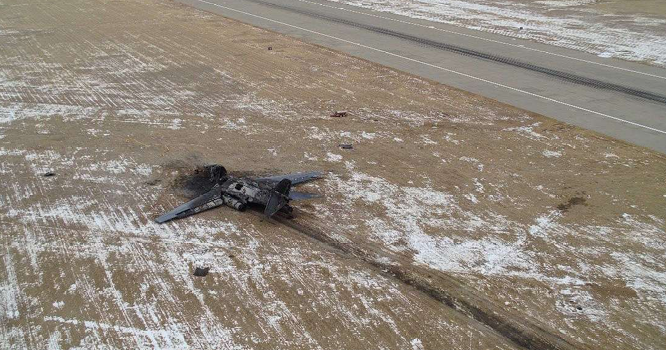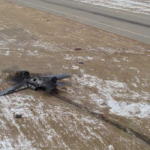A scathing report from the Air Force blamed crew error and weather conditions for the January crash of a B-1 bomber at Ellsworth that resulted in $456.2 million in losses.
Shortly before 6 p.m. on Jan. 4, the B-1 was the second of two aircraft on a training mission in the Powder River Training Complex attempting to land at Ellsworth in rapidly deteriorating conditions.
According to the Air Force Aircraft Accident Investigation Board’s report, the aircraft touched down 100 feet short of the runway, with the rear radome hitting the ground and the landing gear striking the approach lighting. The four-person crew was able to eject successfully, with two airmen reportedly injured as a result. The B-1 then slid around 5,000 feet, eventually catching fire and coming to rest between two taxiways.
People are also reading…
The aircraft was a total loss.
A photo of the B-1’s final resting place.
Col. Erick Lord, president of the Accident Investigation Board, identified the crew’s failure to crosscheck instruments as the cause of the crash.
“The [Mishap Pilot] did not effectively crosscheck the airspeed, descent rate, and projected aircraft flight path leading up to the mishap. By failing to crosscheck using his instruments effectively, the [Mishap Pilot] did not recognize the [Mishap Aircraft’s] deviations from the desired airspeed, descent rate, and aircraft flight path,” Lord wrote in a statement of opinion.
None of the crew have been publicly identified. The board’s report stated the pilot had accrued nearly 260 flight hours since becoming qualified in early 2021, though it also highlighted several previous comments from instructors regarding “a history of unstable approaches, an early transition to visual from an ILS, shifting aim points and excessive power pulls during crosswind landings.”
The B-1’s initial touchdown point.
The instructor pilot during the mishap flight was a qualified command pilot with more than 2,000 flight hours — nearly 700 of which were combat hours.
The report also cited five “substantially contributing factors” to the crash, including undetected wind shear, ineffective flying operations supervision and a failure to adequately manage crew resources.
“The lack of awareness of airfield conditions, particularly amongst aircrews and their leadership of weather sensor outages that prevented requisite personnel from having accurate visibility readings for Runway 13; and an unhealthy organizational culture that permitted degradation of airmanship skills, inadequate focus on governing directives, lack of discipline, and poor communication regarding airfield conditions and hazards,” the AIB report stated.
But the report also found discrepancies and breakdowns in operational communications across the board, both within the aircraft, in pre-flight and with Ellsworth’s control towers.
A weather sensor along the runway had been malfunctioning for months, and it was determined the air traffic control tower knew visibility was zero, yet failed to communicate to the squadron. Both aircraft crews also testified to the board they flew their mission without briefing or knowledge of the Notice to Airmen that would have informed the crew of increased visibility minimums for landing.
Two crewmembers had positive toxicology tests after the crash. The instructor pilot was significantly injured and temporarily unconsious after the ejection sequence, resulting in hospitalization. The AIB determined the instructor pilot exceeded the maximum safe weight limit of the ejection seat, leading to the injuries.
Additionally, the report cited a “leadership vacuum,” a glaring hole in the command organizational structure of the 28th Bomb Wing that “fostered inadequate supervision, an inability to identify and communicate airfield hazards properly and the [Wing’s] inability to recognize and control risk properly.”
A B-1B Lancer takes off at Ellsworth Air Force Base during Combat Raider Media Day.
Ellsworth’s B-1 fleet was temporarily relocated to Dyess Air Force Base in Texas following the crash.
The B-1B Lancer is the backbone of America’s long-range bomber force, a multi-mission aircraft carrying the largest conventional payload of guided and unguided weaponry in the Air Force’s inventory. The first production B-1B flew in October 1984, and was first used in combat in support Operation Desert Fox in Iraq in December 1998. In the decades since, it has garnered nearly 50 world records for speed, payload, range and time of climb in its class.
Ellsworth is set to host the B-21 Raider, a sixth-generation stealth aircraft that will mark the next evolution of Air Force capability. Now in test flight at Northrop Grumman’s facility in Palmdale, California, the first B-21’s are set to arrive in South Dakota sometime in the mid-2020s.
Darsha Dodge is the Interim Editor-In-Chief of the Rapid City Journal. Contact Darsha at ddodge@rapidcityjournal.com.





